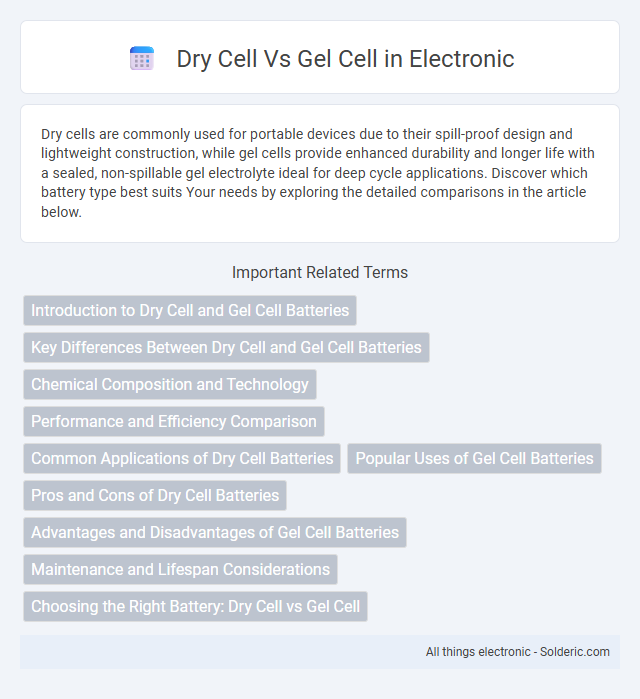Dry cells are commonly used for portable devices due to their spill-proof design and lightweight construction, while gel cells provide enhanced durability and longer life with a sealed, non-spillable gel electrolyte ideal for deep cycle applications. Discover which battery type best suits Your needs by exploring the detailed comparisons in the article below.
Comparison Table
| Feature | Dry Cell | Gel Cell |
|---|---|---|
| Electrolyte | Paste (acid immobilized) | Gelified sulfuric acid |
| Spill Resistance | Moderate | High, leak-proof |
| Maintenance | Low, sealed | Maintenance-free |
| Common Use | Flashlights, remote controls | Solar systems, wheelchairs, UPS |
| Charge Retention | Moderate | Better, slower self-discharge |
| Lifespan | Shorter cycle life | Longer cycle life |
| Cost | Lower | Higher |
| Performance in Orientation | Can leak if tipped | Can operate in any position |
Introduction to Dry Cell and Gel Cell Batteries
Dry cell batteries use a paste electrolyte, making them leak-resistant and suitable for portable devices, while gel cell batteries contain a silica-based gel electrolyte that enhances durability and prevents spillage. Gel cells are commonly preferred in deep-cycle applications due to their higher resistance to vibration and longer lifespan compared to standard dry cells. Understanding the differences in electrolyte composition and performance can help you choose the right battery type for your specific energy needs.
Key Differences Between Dry Cell and Gel Cell Batteries
Dry cell batteries use a paste electrolyte that allows them to be lightweight and leak-resistant, making them ideal for portable devices. Gel cell batteries contain a thickened, gel-like electrolyte that improves durability and prevents spillage, often used in deep-cycle applications like solar energy systems and wheelchairs. Understanding these key differences helps you select the right battery type for optimal performance and safety in your specific use case.
Chemical Composition and Technology
Dry cells primarily use an acidic or alkaline electrolyte in a paste or gel form, typically zinc-carbon or alkaline chemistry, ensuring portability and leak resistance. Gel cells employ a silica-based gel electrolyte that immobilizes sulfuric acid in lead-acid batteries, enhancing vibration resistance and preventing spillage. The key technological difference lies in the electrolyte state, with dry cells favoring solid or semi-solid electrolytes for compactness, while gel cells utilize gel electrolytes for durability and safety in sealed battery designs.
Performance and Efficiency Comparison
Dry cell batteries offer reliable performance with moderate energy density, ideal for low-drain devices, while gel cell batteries provide superior efficiency and longer cycle life, especially in high-drain or deep discharge applications. Gel cells utilize a silica-based electrolyte that prevents leakage and enhances thermal stability, resulting in consistent power output and better overall durability. Choosing the right battery type for your device depends on balancing performance needs with efficiency, where gel cells typically outperform dry cells in demanding environments.
Common Applications of Dry Cell Batteries
Dry cell batteries are commonly used in portable electronic devices such as flashlights, remote controls, and handheld gaming consoles due to their lightweight and spill-proof design. They are also favored in small appliances like calculators, wall clocks, and toys because of their reliable voltage output and ease of replacement. Their widespread availability and affordability make them the preferred choice for everyday household and low-drain applications.
Popular Uses of Gel Cell Batteries
Gel cell batteries are widely used in renewable energy systems such as solar power setups due to their resistance to leakage and deep discharge capabilities. These batteries are preferred in marine and off-grid applications where maintenance-free operation and durability are critical. Emergency backup power systems also leverage gel cell technology for reliable, long-lasting energy storage.
Pros and Cons of Dry Cell Batteries
Dry cell batteries offer portability and convenience with a sealed design that reduces leakage risk, making them ideal for everyday devices like flashlights and remote controls. However, they tend to have a shorter lifespan and lower energy density compared to gel cells, which limits their use in high-drain or long-duration applications. Your choice depends on whether you prioritize affordability and widespread availability or longer-lasting performance and better resistance to extreme conditions.
Advantages and Disadvantages of Gel Cell Batteries
Gel cell batteries offer enhanced leak resistance and superior performance in deep discharge cycles, making them ideal for applications requiring reliable, maintenance-free power sources such as wheelchairs and solar energy systems. Their advantages include longer lifespan, better vibration resistance, and minimal risk of acid spillage compared to traditional dry cell batteries. However, gel cells tend to have higher initial costs and lower high-rate discharge capabilities, limiting their suitability for high-drain applications like power tools or emergency starters.
Maintenance and Lifespan Considerations
Gel cells require less maintenance than dry cells because they are sealed and resist evaporation and leaks, making them ideal for tricky environments. Dry cells need regular electrolyte checks and topping up, impacting their overall lifespan if neglected. Your choice affects long-term reliability, with gel cells typically offering a longer lifespan due to their stable gel electrolyte composition.
Choosing the Right Battery: Dry Cell vs Gel Cell
Dry cell batteries offer a cost-effective, lightweight option suitable for low-drain devices and short-term use, featuring a liquid electrolyte that may leak under certain conditions. Gel cell batteries employ a thickened gel electrolyte providing enhanced durability, vibration resistance, and superior performance in deep-cycle applications such as solar energy systems and wheelchairs. Selecting between dry cell and gel cell depends on device energy demands, environmental conditions, and required battery lifespan.
Dry cell vs Gel cell Infographic

 solderic.com
solderic.com